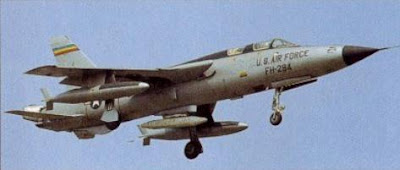The F-105 Thunderchief was a fighter-bomber in service with the US Air Force during the Cold War years. It was designed, developed and built by Republic Aviation. Its prototype, the YF-105A, performed its maiden flight on October 22, 1955, being introduced on May 27, 1958. It first saw combat action in 1964, in Southeast Asia, during the Vietnam War. It was known as the 'Thud' by the American pilots.
The F-105B was the first version that went into mass production. The main feature of this aircraft was its all-weather bombing system. It was the Weapons System 606A, which included the AN/APN-105 Doppler all-weather navigation system, the General Electric FC5 flight control system, the MA-8 fire control system, and the Bendix central air data computer.
Below, the F-105B in 1959.
However, the most important variant would be the F-105D, which had an enlarged nose to make room for the new bombing navigation system; the AN/ASG-19 radar. 650 F-105D aircraft were made from a total of 845 Thunderchiefs. The F-105F version would also be built; it was a two-seat trainer. Meanwhile the EF-105F Wild Weasel was a specialized version designed to suppress enemy air defenses.
Having overcome many technical problems, which caused a series of crashes, the Republic F-105D Thunderchief would become the main fighter-bomber during the first years of the Vietnam War. In the ground-attack role, it was more effective than the F-100 Super Sabre, due to its bomb-load capacity. It carried out air raids not only in South Vietnam but also in Laos and North Vietnam, taking part in Operation Rolling Thunder (1965-1968). However, this aircraft suffered heavy losses due to North Vietnamese Army's SAMs.
Technical Characteristics
The Republic F-105 Thunderchief was a single-seat, single-engine, jet aircraft. It was able to fly at supersonic speeds at very low altitude; this was its main capability. It had a swept, mid-wing configuration. Its tailplane was also a swept back design. Fuselage was all-metal and cylindrical, with the engine air intakes set up on the sides. It had additional fuel tanks, which extended its ferry range to almost 3,000 km.
Specifications
Type: fighter-bomber
Length: 20 m (64 ft, 3 in)
Wingspan: 10.65 m (34 ft, 11 in)
Wing Area: 35.76 square meters (385 sq. ft)
Height: 6 m (19 ft, 8 in)
Power Plant: one Pratt & Whitney J75-P-19W axial turbojet engine, delivering almost 118 kilonewtons of thrust with afterburner.
Maximum Speed: Mach 2.1 (2,230 km/h - 1,385 mph) at 11,000 m of altude; Mach 1.2 at low level.
Combat Range: 1,500 km.
Ceiling: 15,800 m.
Armament: one 20mm M61A1 Vulcan cannon; bomb-load 6,700 kg (eight 340-kg bombs).
Below, two Republic F-105 Thunderchief fighter-bombers in flight in the skies over Vietnam, in late 1964.
Drawing of the F-105D version
Below, the F-105D variant in 1963.






